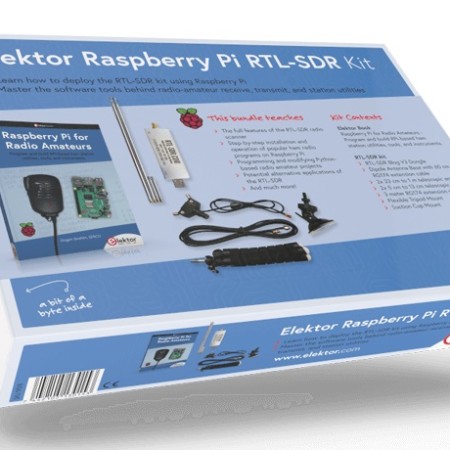Unboxing the Raspberry Pi RTL-SDR Kit
May 09, 2021
on
on
Computers and digital techniques have become very popular among amateur radio operators as even a cheap Raspberry Pi computer can run almost all amateur radio software. Together with an RTL-SDR USB stick a low-cost software-defined radio (SDR) system is obtained sporting a rich feature set.
A basic system may consist of an RTL-SDR dongle with a suitable antenna and a Raspberry Pi with an audio output. With such a simple setup it is feasible to receive signals from around 24 MHz to over 1.7 GHz from stations utilizing different bands including MW/SW/LW broadcast, ham radio, utility, air traffic control, PMR, SRD, ISM, CB, weather satellite, and radio astronomy.
Besides the RTL-SDR dongle with its dipole antenna kit, the book Raspberry Pi for Radio Amateurs (by Dogan Ibrahim, Elektor, 2020) is included in the kit too. The book is suitable for the full range of beginners through old hands at ham radio. Step-by-step installation of the operating system is described with many details on the commonly used Linux commands.
Example projects developed in the book include a station clock, waveform generation, transistor amplifier design, active filter design, Morse code exerciser, frequency counter, RF meter, and more. The block diagram, circuit diagram, and complete Python program listings are given for each project, including the full description of the projects.
A basic system may consist of an RTL-SDR dongle with a suitable antenna and a Raspberry Pi with an audio output. With such a simple setup it is feasible to receive signals from around 24 MHz to over 1.7 GHz from stations utilizing different bands including MW/SW/LW broadcast, ham radio, utility, air traffic control, PMR, SRD, ISM, CB, weather satellite, and radio astronomy.
Besides the RTL-SDR dongle with its dipole antenna kit, the book Raspberry Pi for Radio Amateurs (by Dogan Ibrahim, Elektor, 2020) is included in the kit too. The book is suitable for the full range of beginners through old hands at ham radio. Step-by-step installation of the operating system is described with many details on the commonly used Linux commands.
Example projects developed in the book include a station clock, waveform generation, transistor amplifier design, active filter design, Morse code exerciser, frequency counter, RF meter, and more. The block diagram, circuit diagram, and complete Python program listings are given for each project, including the full description of the projects.
Read full article
Hide full article



Discussion (0 comments)